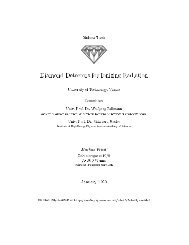You also want an ePaper? Increase the reach of your titles
YUMPU automatically turns print PDFs into web optimized ePapers that Google loves.
the required processing is mostly confined to re-ordering the objects from the internalformats (which feature multiple bunch crossing per event) into the pattern file format(one bunch crossing per event). This is done by organizing the internal data in atwo-level index hierarchy (event, relative bunch crossing) that is only collapsed whenthe processing is finished.In addition, the following extra conversions are needed:• The HF energy sums and bit counts are not available in an object format thatcorresponds to the GT input, required for the pattern file. They need to berepacked in the pattern generator.• In order to detect the difference between a disconnected cable and an all-zeroinput (“no muon”) on the GMT inputs, bit 8-15 of the regional muon candidatesare inverted in the electronic representation. Since this is what is represented inthe pattern file, the representation needs to be converted.The flexibility of the CMSSW framework allows the pattern generation to be usedunchanged in all the required use cases.Pattern Generation Process The general production procedure starts from RAWdata files and uses the predefined unpacker sequences to produce the digi-level inputobjects. Figure 5.1 shows the framework configuration used in this case. The onlyprocessing module involved is the pattern generator itself, with the trigger decisiontaken from the actual hardware output (in case of data).Re-running the Global Trigger To test changes to the global trigger’s operation,such as the implementation of a new trigger menu or a change in the hardware rules,the global trigger emulator has to be run alongside pattern generation. Even thougha specific trigger configuration will be provided by the conditions attached to theinput data, the framework es prefer mechanism can be used to override specific parts.Figure 5.2 shows the framework configuration used to simulate a new trigger menuwith existing data.GT/GMT ReadoutThe GTFE board is the interface to the DAQ system for the entire global triggercrate, including the TCS and GMT. Consequently, the readout records sent to DAQand EVM each consist of a number of board payloads. In addition to the bunchcrossing that the L1A occurred in, the readout record also contains data for a numberof surrounding bunch crossings, which helps in detecting synchronization problemsor events spread over multiple bunch crossings. Depending on board firmware andconfiguration, data from either three or five bunch crossings are contained in a singlereadout record. The GTFE board’s ROP chips contain a spy memory to capturereadout records as they are generated. Since the two readout record encapsulate all53












